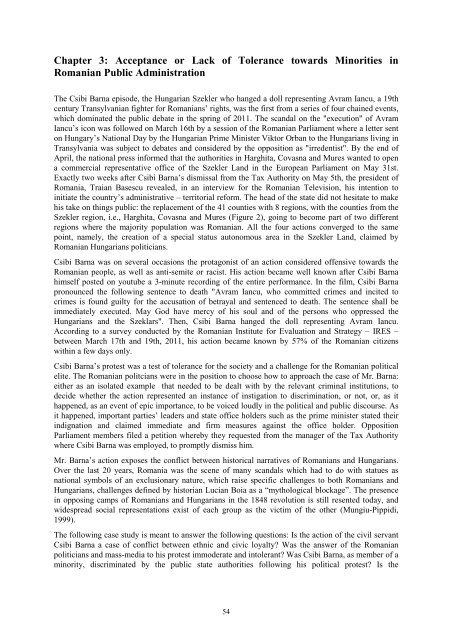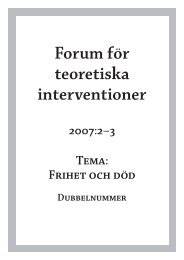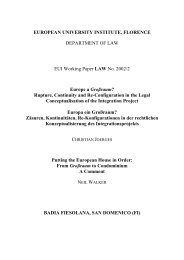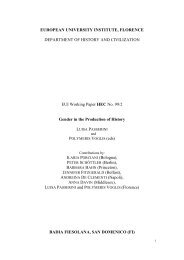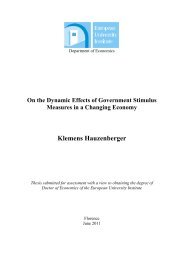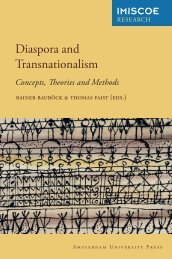Sinziana-Elena Poiana Ioana Lupea Irina-Madalina Doroftei Alina ...
Sinziana-Elena Poiana Ioana Lupea Irina-Madalina Doroftei Alina ...
Sinziana-Elena Poiana Ioana Lupea Irina-Madalina Doroftei Alina ...
You also want an ePaper? Increase the reach of your titles
YUMPU automatically turns print PDFs into web optimized ePapers that Google loves.
Chapter 3: Acceptance or Lack of Tolerance towards Minorities in<br />
Romanian Public Administration<br />
The Csibi Barna episode, the Hungarian Szekler who hanged a doll representing Avram Iancu, a 19th<br />
century Transylvanian fighter for Romanians’ rights, was the first from a series of four chained events,<br />
which dominated the public debate in the spring of 2011. The scandal on the "execution" of Avram<br />
Iancu’s icon was followed on March 16th by a session of the Romanian Parliament where a letter sent<br />
on Hungary’s National Day by the Hungarian Prime Minister Viktor Orban to the Hungarians living in<br />
Transylvania was subject to debates and considered by the opposition as "irredentist". By the end of<br />
April, the national press informed that the authorities in Harghita, Covasna and Mures wanted to open<br />
a commercial representative office of the Szekler Land in the European Parliament on May 31st.<br />
Exactly two weeks after Csibi Barna’s dismissal from the Tax Authority on May 5th, the president of<br />
Romania, Traian Basescu revealed, in an interview for the Romanian Television, his intention to<br />
initiate the country’s administrative – territorial reform. The head of the state did not hesitate to make<br />
his take on things public: the replacement of the 41 counties with 8 regions, with the counties from the<br />
Szekler region, i.e., Harghita, Covasna and Mures (Figure 2), going to become part of two different<br />
regions where the majority population was Romanian. All the four actions converged to the same<br />
point, namely, the creation of a special status autonomous area in the Szekler Land, claimed by<br />
Romanian Hungarians politicians.<br />
Csibi Barna was on several occasions the protagonist of an action considered offensive towards the<br />
Romanian people, as well as anti-semite or racist. His action became well known after Csibi Barna<br />
himself posted on youtube a 3-minute recording of the entire performance. In the film, Csibi Barna<br />
pronounced the following sentence to death "Avram Iancu, who committed crimes and incited to<br />
crimes is found guilty for the accusation of betrayal and sentenced to death. The sentence shall be<br />
immediately executed. May God have mercy of his soul and of the persons who oppressed the<br />
Hungarians and the Szeklars". Then, Csibi Barna hanged the doll representing Avram Iancu.<br />
According to a survey conducted by the Romanian Institute for Evaluation and Strategy – IRES –<br />
between March 17th and 19th, 2011, his action became known by 57% of the Romanian citizens<br />
within a few days only.<br />
Csibi Barna’s protest was a test of tolerance for the society and a challenge for the Romanian political<br />
elite. The Romanian politcians were in the position to choose how to approach the case of Mr. Barna:<br />
either as an isolated example that needed to be dealt with by the relevant criminal institutions, to<br />
decide whether the action represented an instance of instigation to discrimination, or not, or, as it<br />
happened, as an event of epic importance, to be voiced loudly in the political and public discourse. As<br />
it happened, important parties’ leaders and state office holders such as the prime minister stated their<br />
indignation and claimed immediate and firm measures against the office holder. Opposition<br />
Parliament members filed a petition whereby they requested from the manager of the Tax Authority<br />
where Csibi Barna was employed, to promptly dismiss him.<br />
Mr. Barna’s action exposes the conflict between historical narratives of Romanians and Hungarians.<br />
Over the last 20 years, Romania was the scene of many scandals which had to do with statues as<br />
national symbols of an exclusionary nature, which raise specific challenges to both Romanians and<br />
Hungarians, challenges defined by historian Lucian Boia as a “mythological blockage”. The presence<br />
in opposing camps of Romanians and Hungarians in the 1848 revolution is still resented today, and<br />
widespread social representations exist of each group as the victim of the other (Mungiu-Pippidi,<br />
1999).<br />
The following case study is meant to answer the following questions: Is the action of the civil servant<br />
Csibi Barna a case of conflict between ethnic and civic loyalty? Was the answer of the Romanian<br />
politicians and mass-media to his protest immoderate and intolerant? Was Csibi Barna, as member of a<br />
minority, discriminated by the public state authorities following his political protest? Is the<br />
54


